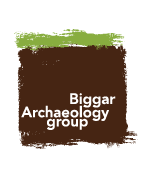The archaeology section of Biggar Museums has now been running for over thirty years. During this time, a vast amount of new data has been gathered by its own volunteers, and also by others engaged in archaeological fieldwork in the area, generally as part of developer-funded projects. Additionally, chance discoveries by individuals have contributed to this body of information that is now fuelling research into specific aspects of the past and of its material culture.
The topics currently being explored by the BAG arise mainly from their detailed exploration of the local landscape over many years. They cover the prehistoric period from the Upper Paleolithic through to the Bronze Age and post-Mediaeval times up to the early 19th Century. Curiously, although there are many large monuments, ranging from Roman camps to hillforts, that date to the intervening period, few domestic structures have been found.
Inevitably, in the course of their investigations, the Group has encountered the barriers imposed by their lack of specialised knowledge and/or technical resources. The need to purchase these imposes a considerable strain on the limited financial resources of the Group who gratefully acknowledge the contributions by numerous sponsors through the years.
The Group is also appreciative of the invaluable assistance provided by specialists on the staff of the National Museums of Scotland and other such bodies. An ideal situation arises where the research interests of the Group coincide with those of the wider archaeological community. A textbook example of this is the case of the recent discovery of the first Palaeolithic site to be identified in Scotland. This involved vital input from Torben Ballin, an individual researcher, and Alan Saville, a lithics specialist with the NMS.
The BAG welcomes enquiries regarding their work and is pleased to make available for research purposes the materials held in store at the Biggar Museums.
The Reports
A number of specialist’s reports have recently been completed and are already available on our website. These include studies of Glenochar and Smithwood Bastle House Bottle Report and other glass objects by Robin Murdoch, of tobacco pipes by Dennis Gallagher and the work on the Arran pitchstone artefacts by Torben Ballin and on Upper Paleolithic materials by him and Alan Saville.
It is crucial that the findings of archaeological researches, and especially of those that involve excavation, are published. Increasingly, this is through the Internet, as witnessed by the growing series of Scottish Archaeological Internet Reports (SAIR). It is accepted that the Internet reports may not accord with the most rigorous academic standards but it is considered that this is more than offset by the speed with which the information is made available to the archaeological community. There are many horror stories of sites that have been excavated and for which no record exists.






